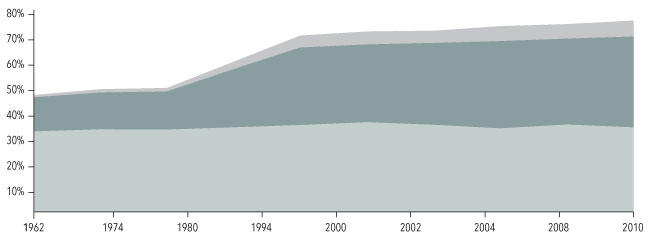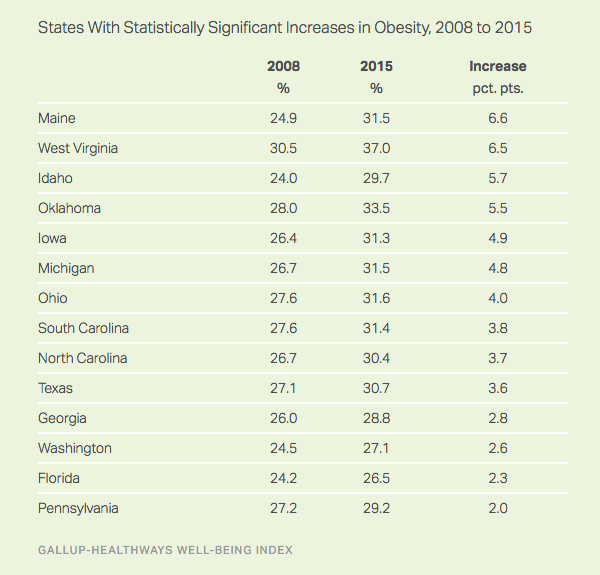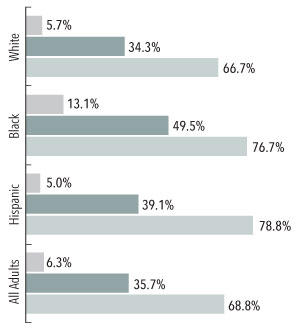Obesity is increasingly becoming one of the major health problems in the United States. A report by Dawes (2014) shows that 34.9% of adult Americans, which translates to about 78.6 million people, are obese. The study also indicated that 17% of children and teenagers aged 2-19 years are also suffering from obesity. It is estimated that by 2020, about ¾ of the Americans will be either obese or overweight if the current trend continues unchecked. Obesity is associated with numerous lifestyle diseases such as coronary diseases, reproductive and endocrinal diseases, neurological problems, and rheumatology problems among a host of other diseases.
According to Kazaks and Stern (2013), obesity in itself makes it difficult for people to move easily and it lowers one’s self-esteem, thereby affecting one’s social environment. The United States’ government and individual Americans spend massive amounts of money to battle obesity and medical conditions associated with it. Those who are affected by this problem cannot lead a normal life as their healthy counterparts and are often forced to rely on friends and relatives to survive.
Majority of Americans understand the dangers associated with obesity. It is, therefore, worrying that even with that knowledge more Americans are likely going to be obese in the near future. It is important to find ways of fighting this problem to ensure that Americans remain healthy. Nurses have a role to play in ensuring that measures are taken to reduce cases of obesity among American population.
Background and Significance of the Disease
Definition and Description of the Disease
Dawes (2014) defines obesity as a medical condition where there is an accumulation of excess fat within the body. In relation to body mass index, one with a BMI, which is greater than 30.0, is considered obese. Obesity can be classified into three main categories. When the BMI is between 35-40 kg/m2, one is considered severely obese. A BMI of 40-44.9 kg/m2 is classified as morbid obesity. A BMI that is 45kg/m2 and above is classified as super obesity. Obesity is a direct result of accumulation of excessive amounts of fat within the body. According to Sonneville, Duggan, and Hendricks (2014), obesity may be caused by poor dieting where one takes more than normal amounts of food.
The starch that cannot be converted into energy is often converted into fat and stored within the body. The more the fat accumulates, the more one gets to be obese. Lack of proper physical exercise is another major reason that causes obesity. In the modern society, many people find themselves so busy that they have limited time for themselves to engage in physical exercise. They leave early in the morning for work in their cars and come back late in the evening. Children have also become less attracted to outdoor physical games.
When they come from school, they prefer engaging in computer games to playing outdoor games. Many parents seem to support the indoor games because they feel that their children are safer within the house than when they are away from the house, especially when there are no adults to supervise their outdoor games. The limited physical activity means that the body will need limited amounts of energy. Significant amounts of food taken will therefore be converted into fat.
Signs and Symptoms
Signs and symptoms of obesity are always easy to detect, especially by people other than the affected individual. An increase in body weight beyond what is considered normal (BMI of 18.5-25 kg/m2) is one of the earliest signs of obesity. When the condition become severe, the affected person may find it difficult to walk normally as was the case before. They tend to tire very fast when engaged in physical activities. They later start finding problems with normal breathing and sleeping become characterized by various problems.
Current Incidence/Prevalence
The United States has one of the most developed service industries in the world. Most of the blue-collar jobs have been moving from the country to China, Mexico, India, and other developing economies. It means that more Americans find themselves doing jobs that require them to use minimal physical energy in high-end offices. The desire to achieve career growth means that most of them spend most of their time at work. The reduced involvement in physical activities among the American population has led to a consistent rise in cases of obesity as shown in the figure below:

As shown in the national statistics above, cases of obesity is on the rise within the country. Over the past 50 years, the number of those who are obese in the country has more than tripled and the trend is continuing. Analysis at state level shows that there are some states where the problem is becoming more prevalent than in others. The table below shows the trend.

As shown in the table above, West Virginia is one of the states where obesity is increasingly becoming a major problem. In 2008, it was estimated that about 30.5% of the total population in West Virginia were obese. In 2015, the number has increased to 37%, clearly indicating that it is a major problem that needs to be addressed in this state.
Current Surveillance Methods
According to Taylor (2015), the National Health and Nutrition Examination Survey and the Centers for Disease Control and Prevention (CDC) have been keen on conducting surveillance about the current state of the problem in the country. The government still relies heavily on self-testing and sharing of the outcome of such tests with the public. The government agencies are also able to collect this data when patients visit hospitals to seek treatments for health problems that may or may not be related with obesity.
Currently, the surveillance method for reporting heavily relies on the willingness of the public to determine and report their BMI as frequently as possible. The main problem faced in the surveillance problem is that many people rarely calculate their BMI on their own. They wait until they have health problems related with obesity that requires medical attention for their BMI to be determined at hospitals.
Descriptive Epidemiology Analysis
Characteristics of the Most Affected Population
Obesity is a problem that affects Americans irrespective of their races or age. However, the Hispanics and the African Americans are the worst affected groups. The figure below shows prevalence of obesity in varying degrees (obese, severe obese, and super obese) of different groups of people in the United States.

As shown in the figure above, severe and super obesity majorly affects African Americans. According to Boero (2012), the prevalence of obesity among African Americans may partly be attributed to genetics. The lifestyle may be another critical characteristic that may help in explaining why the problem is more common among African Americans. According to Kazaks and Stern (2013), the African Americans have historically been marginalized in the American society and most of them are not as financially empowered as the Whites are. Most of them may not afford or have time for exclusive gyms that can help them maintain a physically fit body. With the increasing popularity of unhealthy fast foods and limited exercise, it becomes easy for this population to gain excess weight.
Costs Associated with the Disease
Obesity has a significant economic impact on individuals, corporate, and the nation (Boero, 2012). Individuals have to spend financial resources to address medical problems related to obesity. Corporate, such as health insurance companies, spend a lot of money paying for treatments of obesity-related ailments. The government is forced to budget for medical care for those suffering from obesity-related problems.
In a report by Dawes (2014), the United States spent 190.2 billion, amounting to about 20.6% of all the medical expenses in the country, on managing obesity-related ailments. The financial consequences are also felt when patients cannot go to work and has to rely on family members. Obesity also has social consequences. Stigmatization is one of the prices that most of those who are super obese have to withstand. It may make them feel uncomfortable around colleagues.
How the Disease is Diagnosed
Diagnosis of the Disease
The method that is currently used to diagnose this medical problem is the determination of body index mass (BMI). This method seeks to measure the proportionality of body weight and height. When the BMI is below 18, one would be considered underweight. When it is between 18 to 29.9, one would be considered of normal weight.
A BMI that exceeds 30 kg/m2 is considered overweight or obese. Unlike other health problems, obesity can easily be seen by the affected persons and people around them. When one starts gaining weight rapidly, it should be a warning that such a person is soon becoming obese if measures are not taken to control the situation. It means that even without the standard measure, that uses BMI, it is possible to determine if one is suffering from obesity by looking at the proportionality of body weight and height.
Current National Guidelines for Screening
The current national guidelines for screening people to determine if they are suffering from obesity is to use the measure of body mass index (BMI). Medical practitioners and researchers have reached a consensus that screening for obesity should be based on the proportionality of one’s weight against the height. It means that under normal circumstances, taller people are expected to weigh more than their short colleagues do. This standard is not only in use within the country but also in many other countries around the world.
BMI Screening Test
The use of BMI is a modern and sensitive way of determining whether one is obese or not. The method is specific in terms of providing the ratio of one’s weight and height. It offers a positive predictive value, it is less costly, and is based on the current international standards. One can conduct this test without the need of medical experts.
Plan on How to Address the Epidemiological Disease
Soon after my graduation, I intend to engage in various activities that will help in fighting obesity within my society. The first activity will be to create awareness about the need to have healthy diets. I will try to reach out to the adults and children in various social forums such as schools and places of worship and constantly remind them of the benefits of having healthy diets that can protect them from obesity and related health problems.
The second activity will be to promote awareness about the need to engage in regular physical exercises among adults and children. Using the same forums, I will advice my audience to have a schedule where they can regularly engage in physical exercise at home, in school, or any other place where that can be done. I also intent to help affected individuals overcome their condition by eliminating identified causes of the problem. Obesity may be caused by poor diet, limited physical exercise, and in some cases excessive stress. My goal will be to identify and eliminate possible causes of obesity.
Conclusion
Obesity is currently one of the leading health problems in the United States. Reports indicate that by 2020, three quarters of all Americans will be either overweight or obese if the current trend continues. The government spends over 20% of the healthcare budget in managing obesity and related diseases. It is likely that the resources needed to deal with this problem will increase as the number of those affected increase. Preventive measures should be promoted to avoid the health, economic, and social problems that are associated with the problem.
References
Boero, N. (2012). Killer fat: Media, medicine, and morals in the American obesity epidemic. New Brunswick, NJ: Rutgers University Press.
Dawes, L. (2014). Childhood obesity in America. Cambridge, MA: Harvard University Press.
Jameson, J., DeGroot, L., De, M., Giudice, L., Grossman, A., Melmed, S.,… Weir, C. (2016). Endocrinology: Adult & pediatric. Philadelphia, PA: Elsevier/Saunders.
Kazaks, A., & Stern, J. S. (2013). Nutrition and obesity: Assessment, management, and prevention. Burlington, MA: Jones & Bartlett Learning.
Sonneville, K., Duggan, C., & Hendricks, K. (2014). Manual of pediatric nutrition. Shelton, CT: People’s Medical Publishing House-USA.
Taylor, N. (2015). Schooled on fat: What teens tell us about gender, body image, and obesity. New York, NY: Nicole Taylor.